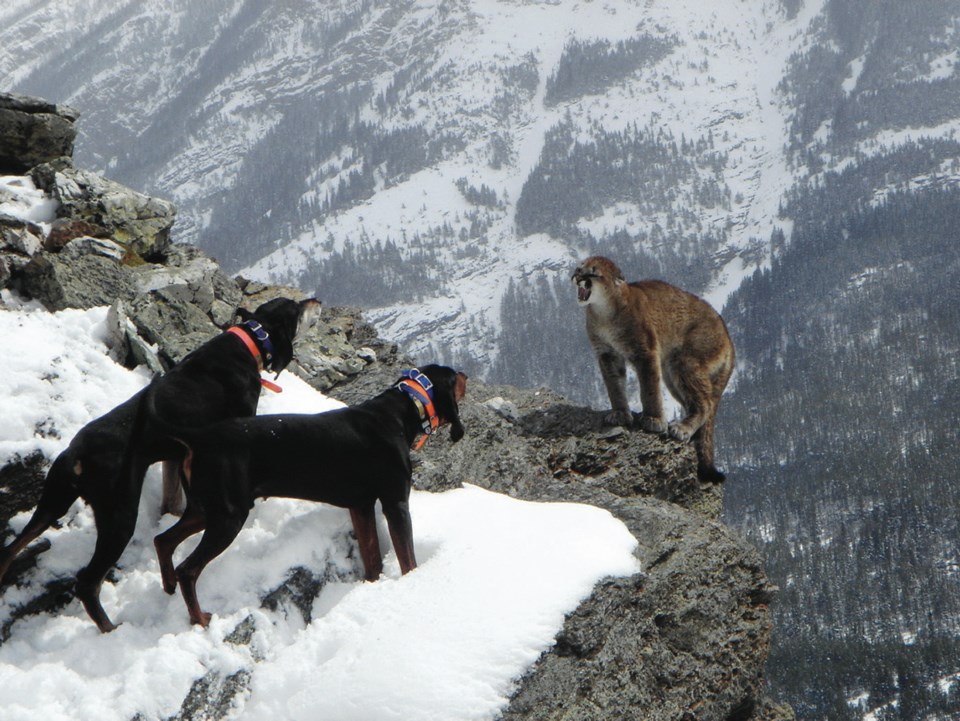Why do Victorians have so many encounters with cougars?
In The Cougar: Beautiful, Wild and Dangerous (Douglas & McIntyre, 288 pp., $34.95), Courtenay author Paula Wild presents an interesting theory.
A professional cougar tracker, George Pedneault of Sooke, has hunted more than 300 cougars over his 60-year career. He believes cougars have followed mysterious trails into Victoria for “as long as the big cats have been on the island.”
In her book, Wild quotes Pedneault: “A cub won’t know to walk along a certain way but somehow it recognizes a path that’s been used by other cougars. They won’t follow it exactly but they won’t be off by more than 100 feet. And they don’t identify it from scent markings — it can be two or more years since another cougar has passed that way but somehow they know.”
For whatever reason, Vancouver Island is a hot spot for cougars. In The Cougar, Wild notes there were 89 documented cougar attacks on humans in British Columbia over two centuries. Fifty took place on Vancouver Island. The Island has not only the highest density of cougars in North America, but the highest number of attacks of anywhere in Canada and the U.S., she said.
Island cougars have a reputation for being “the most aggressive,” Wild says. Theories on why this is vary. Some people say it’s genetics — cougars here are an isolated population that have simply developed in that way. It may be related to wildlife patterns. Deer on Vancouver Island tend to go up to the mountains in the summer and venture closer to town in the winter — followed by cougars, of course.
Wild says the boundary between human and cougar habitat appears to be blurring in modern times. Increasingly, humans take to the wilds for recreation. Meanwhile, young cougars, forced out of prime hunting territories by older, more experienced cats, will venture into the city to eat dogs, cats and raccoons. Not to mention deer, which are plentiful in urban areas within Victoria and other cities.
Wild’s research suggests our city is unique for the high number of cougars seen near the downtown area. In The Cougar, she writes of numerous Victoria cougar invasions.
There’s the infamous Fairmont Empress hotel incident of 1992, when a cougar was captured in the parking garage. In 1989, a woman living downtown was surprised by a cougar that smashed through the glass window of her basement suite. It was shot beside her bed. In 1926, a cougar was shot behind the Carnegie Library building on Yates Street. In 1961, another cougar was killed on the 1400-block of Government Street.
Another book, Island Gold by Dell Hall, lists 21 cougar sightings between 1902 and 1989, all within eight kilometres of Victoria city boundaries.
Wild stresses she’s not out to frighten anyone with The Cougar. Attacks are rare — people are more much more likely to die in a car accident or even from a bee sting or dog bite. Cougars tend to hide or flee if humans are in the vicinity.
Still, she says, it makes sense to be prepared. This occurred to Wild one night when she heard a cougar scream in the woods beside her home. After that, she took forest walks equipped with a whistle on a lanyard, a can of pepper-spray, an air-horn (both in holsters) and a fixed-blade knife.
At the very least, Wild takes her whistle — a good defence because cougars dislike loud, sustained noises.
So what if you’ve forgotten your anti-cougar kit? First, Wild recommends being aware of one’s environment. If birds suddenly “start chirping” or, conversely, if it becomes unnaturally quiet — that could be a tip-off a cougar’s lurking. If confronted by a cougar, fling sticks and stones. Make yourself look large as possible by throwing up your arms. Make noise. And maintain eye contact — it’s a way of establishing dominance.
Wild travelled all the way to Clinton to take a self-defence course from cougar expert Dave Eyer. As part of the two-day course, participants were “charged” by life-size cougar cut-outs. Propelled by a pulley system, the fake-cougars zoomed up at 72 kilometres an hour.
Wild failed this particular test. Panicking, she closed her eyes and squirted bear spray to the right of her target. “If that would have been a cougar,” she said with a laugh, “ it would have been all over me.”
Despite all, she retains an admiration for the cougar. Asked why she wrote her book, Wild said that, like most of us, the cougar fascinates her with a mystique all its own.
“They’re such secretive, magnificent animals,” she said.
Paula Wild will sign copies of The Cougar: Beautiful, Wild and Dangerous at Munro’s Books on Saturday, Nov. 9, from 2 p.m. to 3 p.m. On Nov. 13, she will give an illustrated talk about her book at the University of Victoria. This free event, open to children, takes place 6 p.m. at the Fraser Building in Room 159.


-thumb.png;w=120;h=80;mode=crop)
